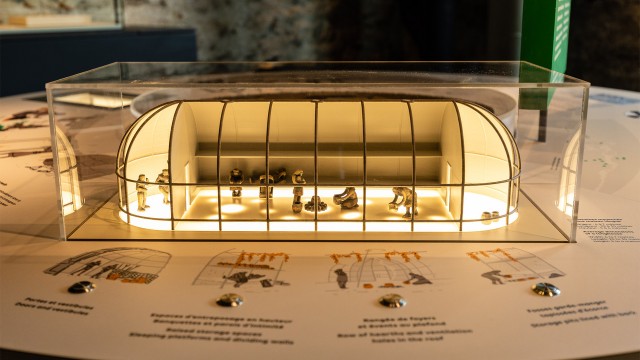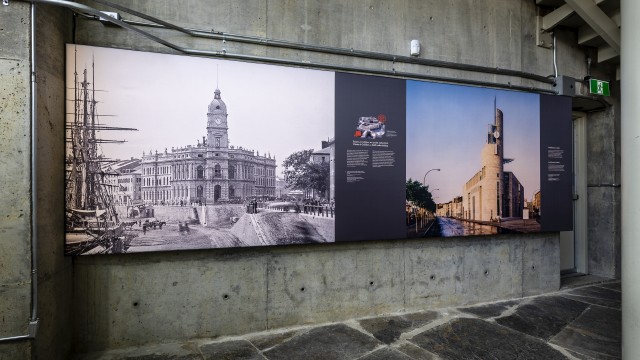Crossroads Montréal

- To learn more about the exhibition Crossroads Montréal
- To download pictures of the exhibition Crossroads Montréal
Please make sure to put the photo credit : Photo : Patrick Desrochers, © Pointe-à-Callière, Cité d'archéologie et d'histoire de Montréal
Press Release
Crossroads Montréal – the fascinating path through the archaeological remains gets a makeover!
Montréal, May 13, 2021 – Pointe-à-Callière invites you to rediscover its Crossroads Montréal exhibition! Its all-new museography brings to life the path through the archaeological remains located beneath the Éperon, the Museum’s main building. Take a fascinating journey, from a stop frequented by hunter-gatherers some 4,500 years ago to the urban neighbourhood of Old Montréal! This site—the only one of its kind in North America—bears witness to the comings-and-goings and meetings of several Indigenous and European peoples.
The exhibition features 150 artefacts. From its earliest human occupation—traces of which date back 4,500 years—the Pointe-à-Callière site has abounded with treasures that reveal it to have been a crossroads of trade between different nations. The strategic geographic positioning of Callière Point, between the little river and the St. Lawrence, was a prime destination over the centuries. The many artefacts, biofacts, and architectural remains found during archaeological digs and magnificently showcased in the Crossroads Montréal exhibition bear witness to the site’s evolution. They tell the story of its successive inhabitants.
Completely redesigned, the new museography, bathed in light, displays the latest historical and archaeological discoveries from various periods of Montréal’s development. The seven stations along the exhibition path encourage visitors to immerse themselves in history by making their way through authentic remains.
As participants in the story being told, visitors take a seat by a campfire. Guided by descendants of the Indigenous peoples that frequented the Point, they are immersed in the spirit of the site. Continuing along the way, they acquaint themselves with a harmonious melody, the nuances and words of native languages—Anicinabe, Kanien’kehá, and Wyandot. The history and way of life of the St. Lawrence Iroquoians are highlighted through several artefacts and interactive installations.
Further on, visitors see remains dating back to 1643—the first catholic cemetery in Ville-Marie— and look back on the events surrounding the signing of the Great Peace treaty of 1701. They learn about the key players in this event, their courage and their exceptional negotiation skills!
The itinerary then moves along towards the 18th century, where a somewhat surprising “Google Map” awaits visitors. A historical adventure rooted in 21st century technology allows people to visit the Montréal of 1708, on foot or on horseback. A magnificent map of Montréal in 1708 is reproduced on an interactive tactile screen, allowing visitors to learn about the city’s inhabitants and their occupations. It offers an exceptional and never-before-seen glimpse of the way in which the little French city was organized. Lastly, with the arrival of the British, the city’s development accelerates, as we witness the construction of the Royal Insurance building, whose shape inspired the architecture of the Éperon, the Museum’s current building.
“The revamping of the Crossroads Montréal exhibition is part of the ongoing revitalization of all of the Museum’s permanent exhibitions undertaken in the last few years, thanks to the financial support of the City of Montréal,” stated Pointe-à-Callière’s Executive Director, Anne Élisabeth Thibault. “The newly showcased remains located beneath the Éperon complete the metamorphosis of our archaeological sites. The approach we have taken puts the human adventure at the centre of the story. It gives us a better grasp of various communities’ vital contributions to the building of the city, which make Montréal the inclusive place it is today,” she added.
Technology and interactivity applied to history
Crossroads Montréal offers a wide variety of experiences for visitors. Technology makes it possible to present didactic content in an entertaining way, just as it allows visitors to immerse themselves in a context of discovery. In addition to the 150 artefacts and objects on display, highlighted remains, light and sound projections, video animation, interactive stations, and works of art—including some by contemporary Indigenous artists—work together to create an active dialogue between the past and the present. They serve to guide visitors and further their understanding of the visible traces of various historical periods and major events that succeeded one another on the site.
An exhibition showcasing the latest scientific discoveries
The exhibition is the result of recent historical and archaeological discoveries. An advisory committee made up of members of Indigenous communities, archaeologists, historians, and anthropologists guided the Museum through the development of its exhibition content. The design and production of Crossroads Montréal was entrusted to the firm GSM Project.
About Pointe-à-Callière, Montréal Archaeology and History Complex
Pointe-à-Callière, the birthplace of Montréal, is the city’s largest history museum. Rising above a concentrated number of national historic and archaeological sites, the museum’s mission is to raise awareness and foster an appreciation of Montréal’s history, and to forge bonds with regional, national, and international networks.
To mark the 29th anniversary of the Museum and the 379th anniversary of Montréal,Pointe-à-Callière will exceptionally open its doors to visitors on Monday, May 17, from 11 am to 5 pm. For the occasion, admission to the Museum will be free of charge for everyone, young and old alike.
Pointe-à-Callière, Proud partner of Ville de Montréal
- 30 -
Source:
Marie-Josée Robitaille
Communications and Marketing Director
Tel: 514 872-9124 / cell: 514 371-7227
[email protected]

